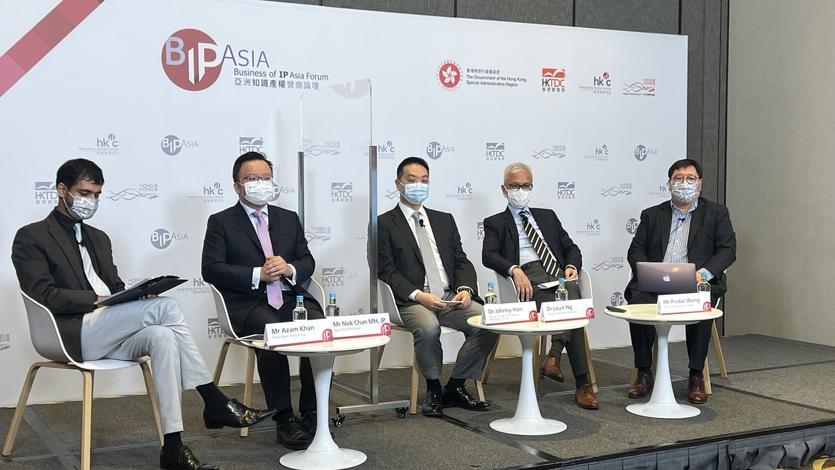Insiders tell forum that digitalization has opened new revenue streams for art and culture
 Four cultural industry leaders (from second left to right) — Nick Chan Hiu-fung, Johnny Hon Sei-hoe, Louis Ng Chi-wa, and Pindar Wong Pin-dar — and moderator Azam Khan, China Daily’s new-media anchor, attend an online seminar with the theme “New IP Trends in Cultural and Arts Industries” on Friday. (PHOTO PROVIDED TO CHINA DAILY)
Four cultural industry leaders (from second left to right) — Nick Chan Hiu-fung, Johnny Hon Sei-hoe, Louis Ng Chi-wa, and Pindar Wong Pin-dar — and moderator Azam Khan, China Daily’s new-media anchor, attend an online seminar with the theme “New IP Trends in Cultural and Arts Industries” on Friday. (PHOTO PROVIDED TO CHINA DAILY)
Amid a digital transformation in the art industry brought by the pandemic, museums and artists are looking into new revenue streams by integrating intellectual property practices with technologies, industry pundits said at a seminar on Friday.
The online seminar, as part of the Business of IP Asia Forum, was jointly organized by the Hong Kong Special Administrative Region government, the Hong Kong Trade Development Council, the Hong Kong Design Centre and China Daily with the theme “New IP Trends in Cultural and Arts Industries”.
“Intellectual property rights play a vital role in supporting a thriving creative economy, as they protect creativity and control the commercial exploitation of the products of the creative industries — an economic balance struck to promote creativity and innovation,” said Johnny Hon Sei-hoe, founder and chairman emeritus of Global Group International Holdings.
Leveraging on IP practices such as brand cooperation and licensing deals, museums could reach broader audiences and diversify their revenue streams in combating the losses induced by the pandemic, said Louis Ng Chi-wa, director of the Hong Kong Palace Museum.
Considered an intangible cultural asset, a museum‘s IP includes all the intellectual property rights owned by museums, Ng said.
“Many museums faced significant losses in revenue through closures during the global pandemic,” he said, adding that the visitor figures for the world’s top 100 art museums dropped by 77 percent in 2020.
More people have visited museums online than in real life in the last year, recording a total number of 1.6 billion visits to museum design stores on Tmall, the online marketplace operated by Alibaba, Ng said.
“In the new museum world, nothing, it seems, is off-limits,” Ng said, prodding museums to grasp the opportunities through licensing deals to transform their business and expand their global audience.
Hon said he believes that technology has changed the way art is bought, sold and developed, adding, “Artificial intelligence, blockchain, virtual and augmented reality are expanding access to the art world, increasing the speed of sales, and fundamentally changing how businesses operate in the art industry.”
Pindar Wong Pin-dar, chairman of internet financial infrastructure consultancy VeriFi (Hong Kong), said non-fungible tokens can benefit artists who can efficiently earn from their intellectual properties.
“The monetization of the artwork sometimes happens many years later when the artists are not alive. The NFTs experiment can solve the paradox. This provides a new way for living artists to make a living,” he said.
Nick Chan Hiu-fung, partner of global law firm Squire Patton Boggs, warned that legal issues regarding intellectual property rights involved in art NFTs should also be considered.
According to Chan, he assumes that the creator of an artwork risks being bound to some standard terms of sale in a public auction through NFTs, while a purchaser risks losing his or her money at a private auction due to a failed hosting site when paying with cryptocurrency.
Chan said he believes that a lot of issues have to be more technologically neutral and future-proof. “Lawyers, artists, and technologists have to come together to overcome this minefield and succeed together,” he said.
Contact the writers at xinlanzeng@chinadailyhk.com


